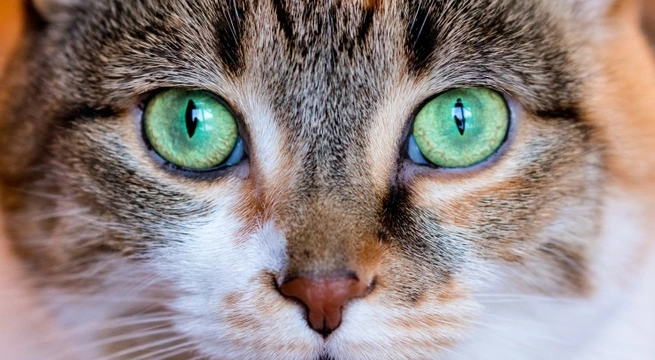
Can cats see in colour?
It can be hard for us as humans to understand that other animals have a rather different view of the world than we do, because their eyes are constructed differently and their vision has evolved to become the most appropriate type to fit the lifestyles and challenges that they face.
Most of us know that dogs don’t have the same acuity for colour that we do, and dogs largely view the world in shades of blues and yellows – but have you ever wondered what type of vision cats have, and the type of colours they can and cannot see?
As you might imagine, your cat’s vision is rather different to your own, and to that of the dog too; the way the eyes of the cat are constructed, their field of vision, ability to see in different lighting conditions and the colours that they see are all unique.
In this article we will answer the question “can cats see in colour?” and discuss what and how cats can see in more detail. Read on to learn more.
What colours can cats see?
First of all, to understand what colours cats can see you need to have a basic understanding of how colours are received by the eyes and translated by the brain.
It is the eye’s nerve cells that identify the things that we see, and these nerve cells come in two types, called rods and cones (reflecting their different shapes). It is the cone cells of the eyes that allow for colour vision and shade differentiation, and these cones in both cats and humans come in three different types, which identify shades of blue, red and green respectively.
Cats and humans both have the same type of colour-sensitive cone cells in their eyes, but humans have a lot more of them – around ten times more than cats do in fact. This means that whilst both cats and humans can see the same three core colour groups, humans can pick out many more subtle shades and colour variations than cats can. Additionally, we’re not actually sure if cats can see shades within the yellow spectrum (as dogs can) or not.
The other type of nerve cells in the cat’s eyes are the rod cells, and these cells are responsible for detecting motion, and lighting levels. This in turn impacts upon the types of colours cats can see in different types of lighting conditions.
How does feline vision stack up against human vision?
When it comes to colour vision, cats can see a fairly broad range of different colour groups and shades, but with less detail than us; colours are apt to look less rich and vibrant to cats than they are to humans.
Cats are also much more near-sighted than people (an evolutionary trait that allows them to spot and target small prey) and have poorer distance vision, although their ability to pick out movement from close range is much better than ours.
Objects in the distance soon lose clarity and appear blurry around the edges to cats, and their visual range is really only optimum when looking at things within around a 20ft range.
Your cat’s eyes are also positioned rather differently to ours, being less forward-facing and spaced more widely, permitting for a wider range of vision that helps to alert them of the approach of a potential predator. This does also mean however that your cat’s ability to judge depth and distance is not as good as ours.
The pupil of you cat’s eyes is different to your own too, being less rounded and having a greater ability to dilate to maximise the amount of light that enters the retina, improving their ability to see in darkness and dim lighting conditions too. This means that your cat’s vision is at its best at dawn and dusk, and these are the times of day at which hunting cats tend to be the most successful.
How your cat’s vision helps them
The whole construction of your cat’s eyes from their position on the head to how they work are the result of evolution, and designed to give your cat an advantage in their natural environment that helps them to stay safe, meet their needs, and continue to thrive.
The position of your cat’s eyes on their head enables them to seek prey whilst remaining alert to a potential stealth approach from the side, and the trade-off for your cat’s poorer colour vision is the ability to see better than us in poor lighting conditions.
Because being able to see the fine variations in colours has not proven to be a hugely important ability for cats, cats don’t have as great a capacity to see colour as us, but their ability to pick up on even tiny movements close by is vital to successfully hunting for prey, which is something that they beat us at.
Many of us have seen our cats sitting alert watching or waiting for something with great concentration for periods of time as part of hunting or play, and this is where your cat’s superior ability to detect movement comes into its own.



